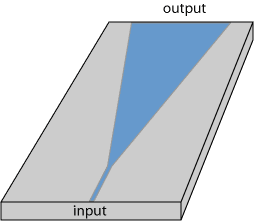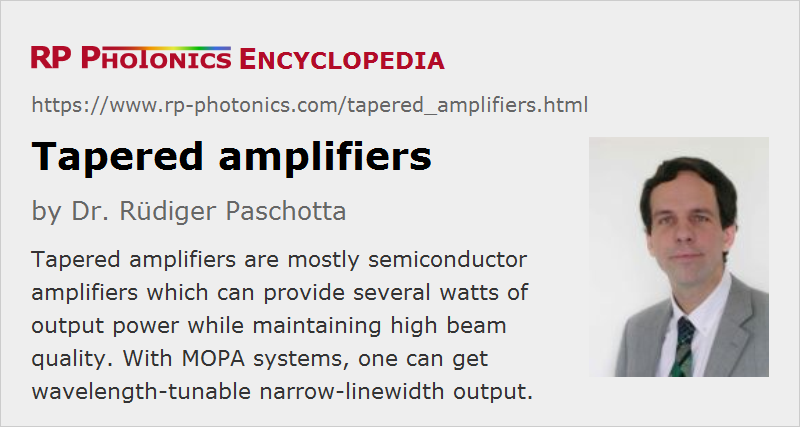Tapered Amplifiers
Definition: optical amplifiers which contain a tapered section, where the beam area is gradually increased
German: Trapezverstärker
Categories: photonic devices, optical amplifiers
How to cite the article; suggest additional literature
Author: Dr. Rüdiger Paschotta
Tapered amplifiers are optical amplifiers containing a tapered section, where the cross-section area of the amplified beam is gradually increased. The term is mostly used in conjunction with semiconductor optical amplifiers (SOAs), although one can in principle also make tapered amplifiers from rare-earth-doped tapered fibers, for example. This article focuses on tapered semiconductor devices, which are available either as bare semiconductor chips or as amplifier modules containing such chips. They can produce output powers of several watts while maintaining a high beam quality, much better than that of other high-power semiconductor laser devices, such as broad area laser diodes.
Operation Principle

Figure 1 shows the basic setup, which is realized on a single semiconductor chip with a length of e.g. 5 mm. The input light is injected into a ridge waveguide, which is only a few microns wide and may support only a single propagation mode per polarization direction. Thereafter, the light gets into the taper region, the width of which may linearly or nonlinearly be increased towards the output end (up to several hundreds of micrometers, for example), while the height typically remains constant (but can be somewhat different from than that of the input region). The whole taper region is covered with an electrode for supplying the pump current (typically a couple of amperes), which makes the device amplifying, just as in a conventional semiconductor optical amplifier: the injection current populates the valance band (typically in multiple quantum wells) with carriers such that laser gain is obtained. The input waveguide region is usually also pumped – possibly via a separate electrode.
While the input ridge waveguide is typically index-guiding, the taper region can also be based on gain guiding.
The beam profile continuously expands horizontally in the taper region and normally maintains a smooth amplitude envelope, so that the beam quality stays quite high – typically with an M2 factor well below 2 for the horizontal direction and even closer to 1 (diffraction-limited) for the vertical direction. The beam quality in the horizontal direction is far better than that of a broad area laser diode, having a strongly multimode output.
For optimized performance, the tapered amplifier design can contain additional elements, such as cavity-spoiling groves approaching the transition region between ridge waveguide and taper region, which can suppress parasitic lasing.
Note that there are also tapered laser diodes, which can lase without additional optical feedback.
MOPA Systems with Tapered Amplifiers
It is common to use a tapered amplifier as part of a master oscillator power amplifier (MOPA) system (see Figure 2). The seed laser is normally a laser diode, e.g. a distributed-feedback laser with narrow linewidth, or some other kind of laser diode which may be wavelength-tunable. One may also use an external-cavity diode laser as seed laser.
In most cases, such systems are used with continuous-wave operation. Only to a limited extent, the amplification of pulses is possible, since the saturation energy of a semiconductor amplifier is quite small.

Because the Fresnel reflection from the input and is hard to completely suppress, one will typically require a Faraday isolator between seed laser and amplifier. Besides, one requires some collimation and focusing optics before and after the isolator. Because of the feedback sensitivity of a high-gain amplifier, one may need an additional Faraday isolator at the output.
Such a kind of amplified laser system can fit into a quite compact and rugged package, which for convenience may be equipped with fiber coupling.
External-cavity Diode Lasers
One can also incorporate a tapered amplifier into an external-cavity diode laser (ECDL), where additional optical elements may be introduced for wavelength tuning or linewidth reduction. Normally, such elements will be included on the input side of the amplifier, and the Fresnel reflection of the output side (possibly modified with a coating) can be used as the output coupler mirror. For example, such an amplifier may be equipped with a collimation lens and a rotatable diffraction grating in Littrow configuration for realizing a tunable laser (see Figure 3).

Frequency Doubling
For reaching shorter wavelength regions, one can employ frequency doubling. While this would normally be difficult with other semiconductor laser systems, tapered amplifiers make frequency doubling relatively easy because of the combination of high power and high beam quality. One possibility is to use resonant frequency doubling, if single-frequency operation is achieved. Alternatively, one may perform efficient single-pass frequency doubling in a nonlinear waveguide.
Performance of Tapered Amplifier Systems
Tapered semiconductor amplifier systems can provide output powers of several watts while maintaining high beam quality, often combined with a narrow linewidth and wavelength tunability e.g. over 20 nm or even 50 nm. The amplifier gain is often of the order of 20 dB.
Such sources can compete with fiber amplifiers systems, and can easily be realized in some wavelength regions where suitable fiber amplifiers are not even available – for example, around 850 nm. Also, the cost of a tapered amplifier system can be substantially lower.
Note, however, that the output beam of a tapered amplifier is strongly asymmetric – much wider in the horizontal direction – and strongly divergent in the vertical direction. Therefore, more sophisticated optics (with cylindrical lenses) are required for generating a collimated beam with a circular beam profile, for example. In that respect, a fiber amplifiers are easier to handle; also, they can generate much higher output powers.
Applications
Tapered amplifier systems are used for various applications where one requires 1 W or several watts of output power in conjunction with high beam quality and possibly a narrow linewidth. Some examples:
- One can use high-power narrow-linewidth lasers in various scientific and technical applications like Raman spectroscopy, optical metrology, interferometry, laser cooling and laser absorption spectroscopy.
- There are frequency-doubled laser systems which can be used in RGB sources.
Suppliers
The RP Photonics Buyer's Guide contains 12 suppliers for tapered amplifiers. Among them:

TOPTICA Photonics
Tapered amplifier (TA) diodes amplify laser radiation into a nearly diffraction limited beam to powers that would destroy the facets of normal laser diodes. At the same time the spectral properties of the master laser are preserved. TOPTICA offers TA chips separately, but also integrates them into convenient laser systems (TA pro and BoosTA).
Questions and Comments from Users
Here you can submit questions and comments. As far as they get accepted by the author, they will appear above this paragraph together with the author’s answer. The author will decide on acceptance based on certain criteria. Essentially, the issue must be of sufficiently broad interest.
Please do not enter personal data here; we would otherwise delete it soon. (See also our privacy declaration.) If you wish to receive personal feedback or consultancy from the author, please contact him e.g. via e-mail.
By submitting the information, you give your consent to the potential publication of your inputs on our website according to our rules. (If you later retract your consent, we will delete those inputs.) As your inputs are first reviewed by the author, they may be published with some delay.
Bibliography
| [1] | D. C. Hall et al., “Carrier-induced lensing in broad-area and tapered semiconductor amplifiers”, IEEE Photon. Technol. Lett. 6 (2), 186 (1994), doi:10.1109/68.275423 |
| [2] | M. Chi et al., “Tunable high-power narrow-linewidth semiconductor laser based on an external-cavity tapered amplifier”, Opt. Express 13 (26), 10589 (2005), doi:10.1364/OPEX.13.010589 |
| [3] | S. Stry et al., “Widely tunable diffraction limited 1000 mW external cavity diode laser in Littman/Metcalf configuration for cavity ring-down spectroscopy”, Appl. Phys. B 85, 365 (2006), doi:10.1007/s00340-006-2348-1 |
| [4] | I. Hassiaoui, “Very compact external cavity diffraction-coupled tapered laser diodes”, Appl. Opt. 47 (6), 746 (2008), doi:10.1364/AO.47.000746 |
| [5] | M. Chi et al., “Tunable high-power narrow-spectrum external-cavity diode laser at 675 nm as a pump source for UV generation”, Appl. Opt. 50 (1), 90 (2011), doi:10.1364/AO.50.000090 |
| [6] | O. B. Jensen et al., “Widely tunable high-power tapered diode laser at 1060 nm”, IEEE Photon. Technol. Lett. 23 (21), 1624 (2011), doi:10.1109/LPT.2011.2165702 |
See also: optical amplifiers, semiconductor optical amplifiers, tapered laser diodes, master oscillator power amplifier, narrow-linewidth lasers
and other articles in the categories photonic devices, optical amplifiers
 |



If you like this page, please share the link with your friends and colleagues, e.g. via social media:
These sharing buttons are implemented in a privacy-friendly way!